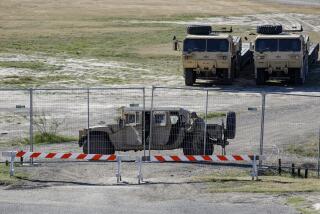Parks at a loss
- Share via
With the always-frantic Independence Day weekend looming, a nation jittery over potential terrorist attacks will find some national parks short-handed because the federal government has redeployed personnel for homeland security duty.
Throughout the summer, more rangers will guard Mt. Rushmore and more officers will patrol the St. Louis Gateway Arch during heightened terrorist alerts. The Interior Department has identified both sites, as well as pipelines in the canyon country near Four Corners, as among 19 potential terror targets, and will move rangers to them, leaving other parks with fewer staffers to confront belligerent campers and tranquilize marauding bears.
Visitors will enjoy their monuments, historic sites and recreation areas despite the personnel shuffle, says National Park Service spokesman David Barna, adding that at some parks the change will mean “cutting the grass once a week instead of twice.”
Others aren’t as sanguine.
“Pulling rangers out of parks means there’s no longer rangers to prevent vandalism, poaching and other crimes,” says Jeff Ruch, executive director of Public Employees for Environmental Responsibility.
After Congress urged Park Service police to concentrate on protecting the Washington Mall, drug investigations and traffic enforcement dropped at other sites, and the agency’s top cop, Teresa Chambers, went public with concerns about declining safety. She said the 620-member nationwide park police force, which guards such national treasures as the Statue of Liberty, the Washington Monument and San Francisco’s Presidio, needed a major expansion in the post-Sept. 11 era. Last December, the Park Service placed Chambers on administrative leave for talking to a reporter about the problems.
The Park Service has spent about $50 million of its $1.6-billion annual budget on homeland security measures this year, but advocates for the national parks say the budget was stretched dangerously thin before the Sept. 11 attacks and scold Washington for failing to kick in more money for homeland security.
One park ranger is available for each 10 square miles of land, and one employee is available per 32,000 visitors, according to the Assn. of National Park Rangers. The group’s report, released in April, concludes that staff and budget constraints could force the Park Service to merge or close seven parks by 2009.
This summer, during orange alerts, some park visitors will experience the rearrangement of resources when rangers search unattended backpacks and watch visitors with surveillance cameras.
Meanwhile, budget cuts are forcing some sites to close their gates early.
Joshua Tree, Yellowstone and Organ Pipe Cactus parks have cut educational programs, and Congress has suggested extending the temporary $20 park entrance fee at national parks beyond the scheduled September expiration to help pay for anti-terror measures.
Each time the Homeland Security Department raises the nation’s current yellow alert status to orange, the Park Service says it spends an additional $1 million a month to enforce such measures as barring pedestrians from the Golden Gate Bridge, closing some trails and herding visitors to Mt. Rushmore through metal detectors.
The House Government Reform committee has requested that the General Accounting Office, the investigative arm of Congress, examine the effects of homeland security on the national parks -- places that for many Americans are synonymous with summer.
The report is scheduled to be released in November.
More to Read
Sign up for Essential California
The most important California stories and recommendations in your inbox every morning.
You may occasionally receive promotional content from the Los Angeles Times.










